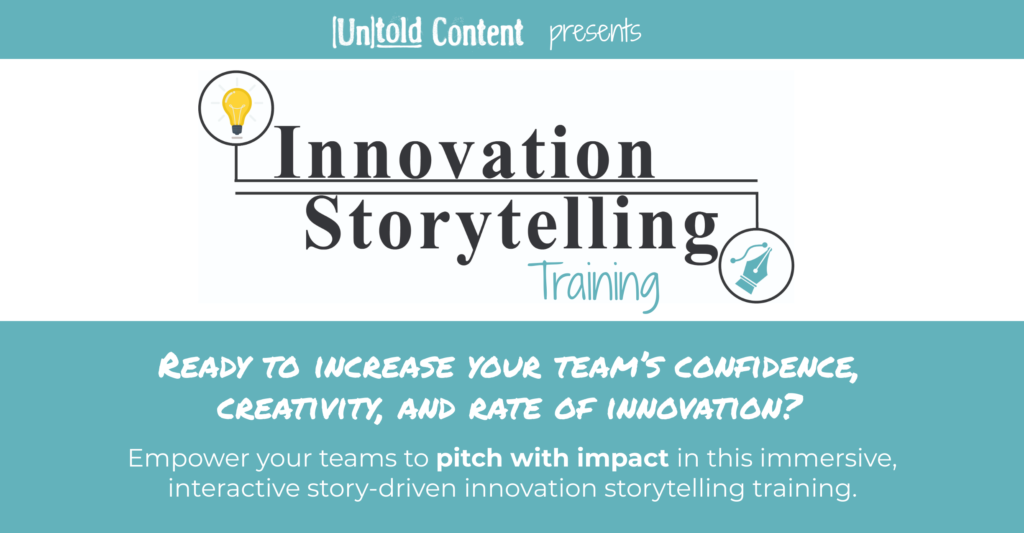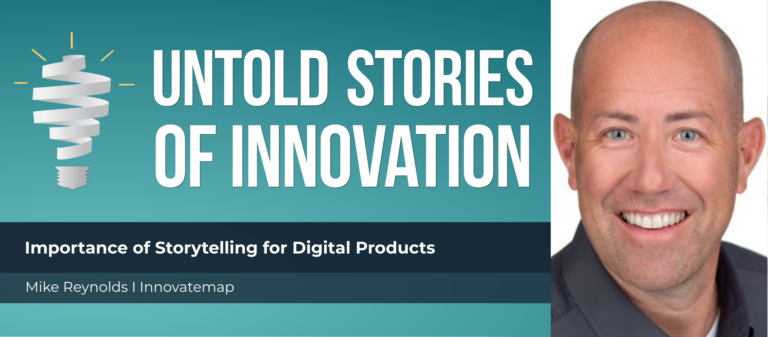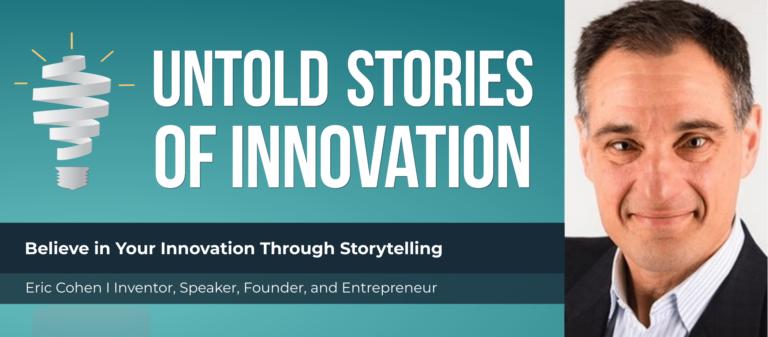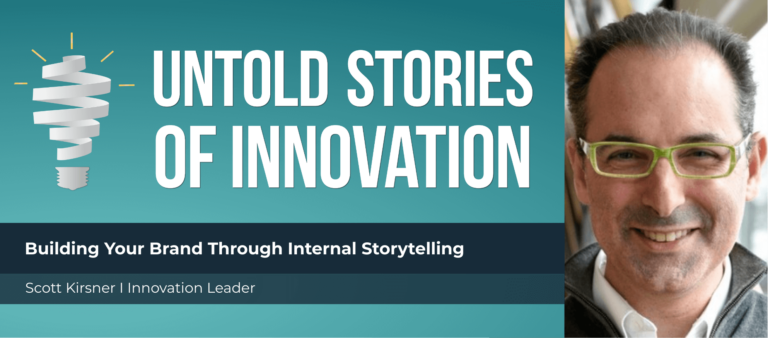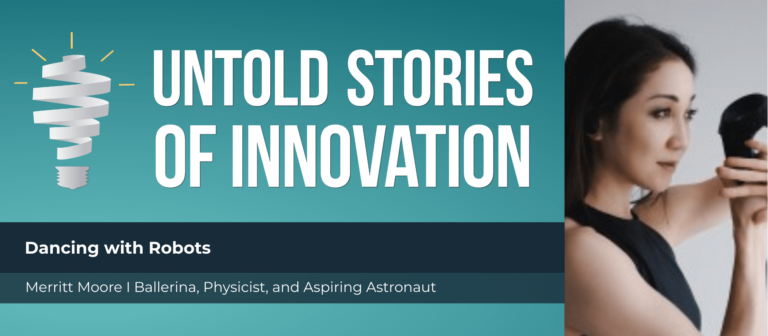Inspiring Insight-Driven Innovation with Sue Baggott
Untold Stories of Innovation
“It's all about being super curious about the people that you're serving. Deeply understanding their needs, what their current reality is, what the future experience could or could be, and then using that to set your innovation direction or your design direction.” - Sue Baggott, Strategic Innovation Consultant
From today’s episode you’ll learn:
Why do stories matter to the innovation process? What values can be instilled in innovators who Insight-Driven Innovation share stories? How do innovation leaders inspire creators to tell and share their success and failure stories?
We speak with Sue Baggott, a former BigCo executive turned strategic innovation consultant, and now President of the Power Within Consulting. An accidental angel investor and lean innovation leader, Sue shares the value of approaching consumers with empathy and attuning to their passions, struggles, and goals. The most impactful innovations emerge from that approach. Sue shares her insight into what innovation storytelling can look like, the key to successful and impactful innovation, and how to garner buy-in and consumer interest in innovative sectors.

Sue Baggott is a strategic, global, innovation leader with a proven track record for uncovering deep customer insights and making non-obvious connections which lead to breakthrough business results. Experienced in driving insight-inspired innovation and business strategy in organizations ranging from Fortune 100 corporations to emerging, high-growth startups. Sue is passionate about creating positive, meaningful, impact in our world and empowering future leaders. Find out more about Sue and her investments at powerwithinconsulting.com.
untoldcontent.com/trainings/innovation-storytelling-training
TRANSCRIPT
This episode, Insight-Driven Innovation is powered by Untold Content’s innovation storytelling training. Increase buy in for your best ideas in this immersive and interactive, story-driven experience. Where your teams refine storytelling techniques for their latest projects, prototypes and pitches—and get inspired by 25 epic examples of impactful innovation stories. Learn more at https://untoldcontent.com/innovationstorytellingtraining-2/.
Katie Trauth Taylor: Insight-Driven Innovation [00:00:04] Welcome to Untold Stories of Innovation, where we amplify untold stories of insight, impact and innovation. Powered by Untold Content. I’m your host, Katie Trauth Taylor.
Katie Trauth Taylor: Insight-Driven Innovation [00:00:19] Our guest today is Sue Baggott. She’s a strategic innovation consultant. She’s also a former executive in large companies. She’s an investor, a board member and a startup mentor. She is the president of Power Within Consulting. And I’m so inspired to have you on the podcast today. Sue, thank you so much for being here.
Sue Baggott: Insight-Driven Innovation [00:00:38] Well, thank you for inviting me. Appreciate it.
Katie Trauth Taylor: Insight-Driven Innovation [00:00:40] Yes. So tell us about where your personal story of innovation begins.
Sue Baggott: Insight-Driven Innovation [00:00:45] So I was really fortunate that I got a window into that area of mastery early on and really fell in love with it. It’s all about being super curious about the people that you’re serving. Deeply understanding their needs, what their current reality is, what the future experience could or could be, and then using that to set your innovation direction or your design direction. But I also like leading organizations. So P&G has two tracks. You can either go down, they call the technical track or management track. And I ended up because I also loved developing capability in others because I loved both [unclear wording] research mastery and the ability to lead organizations or develop that capability in others. I ended up choosing to go up the management track at P&G, but I used my products research mastery as my strength that I leveraged, whether it was on the innovation side or, well, innovation for the consumer or innovation for the organization.
Katie Trauth Taylor: Insight-Driven Innovation [00:01:40] Sure.
Sue Baggott: Insight-Driven Innovation [00:01:40] So I used the skills that I developed there around empathy. So to me, empathy is the center of all innovation. And actually that deep understanding is, you know, innovation, innovation in and of itself to me is not very meaningful. Innovation that helps people, that changes their lives, that transforms their lives. That’s what’s powerful. So I had a unique opportunity. I was still in Europe when that acquisition took place. And so I was offered an assignment to stay in Europe and to start developing the early you know, start doing some of the early development of consumer understanding technology. We did benchmarking. We did all kinds of things to map out the white space there, map out where the opportunities were while still in Europe, I had an opportunity that you don’t typically get as a section head, literally building a lab, building an organization, leading a technology development in foundation. At that time. But cosmetics had so few resources, you had to. You were doing it globally. And you had to run really, really lean because there just weren’t the resources.
Katie Trauth Taylor: Insight-Driven Innovation [00:02:45] Sure.
Sue Baggott: Insight-Driven Innovation [00:02:45] So you had to run lean, but you had to do it globally. So we had a globally dispersed team. So that was another interesting challenge.
Katie Trauth Taylor: [00:02:53] Were you working virtually together then?
Sue Baggott: Insight-Driven Innovation [00:02:54] Yes. Yes. So we did a lot of. So, yes, there were people on the ground, but there were people working virtually. So that was another challenge. But what I learned from that is that these really diverse teams can deliver really transformational results if you can figure out how to. So to be the real key for this is get that deep empathy with your consumer, really understand them functionally, emotionally, life, social, what’s meaningful to them, understand what kind of transformation it takes to get them to that next level and then translate that back into what the technology has to deliver because you’re. And so this is where, you know, storytelling. You have to be able to tell the story of what the consumer wants to, you know, how to design for them. But not everybody who’s out there doing the consumer understanding gets that directly from the consumer or even wants to get it directly from the consumer. Right.
Katie Trauth Taylor: Insight-Driven Innovation [00:03:52] Sure!
Sue Baggott: Insight-Driven Innovation [00:03:52] So you have some of these brilliant technologists that want to contribute to the process. You have to figure out how to translate it back into something that’s meaningful to them. So, yes, they want to understand the consumer, what excites them. They’re not opposed to learning about the empathy, but then they want that translated back into. What does that mean we have to deliver? So I was working on the cosmetics business while my husband and I were still in Europe. We had moved to Europe right after we had gotten married. So we were supposed to be there two to three years we’re now going on four to five years. So during the time we were in Europe, I had agreed to move into cosmetics and we were supposed to stay another two years. And then I found out I was expecting, which was not expected.
Sue Baggott: Insight-Driven Innovation [00:04:30] But…
Katie Trauth Taylor: Insight-Driven Innovation [00:04:32] It happens.
Sue Baggott: Insight-Driven Innovation [00:04:32] Then I wanted to – it happens and I wanted to… We had determined we would rather be back in the U.S. to raise our family in. But I wanted to stay in cosmetics and that was actually a Win-Win, because the cosmetics business, though, it was still global. But the part in the U.S. was out of Baltimore and I’d grown up outside of Philadelphia. So in Baltimore, I actually had much more family support. I had a sister who lived in Baltimore, an aunt who lived in Baltimore. My parents were an hour and a half away.
Katie Trauth Taylor: Insight-Driven Innovation [00:04:56] Something I love about that. That entire story is the way that empathy played a role in the consumer insights that fed into the technical brief. And once you had that clarity among the innovation team, it was much – it sounds like it’s much easier to innovate against an agreed upon, empathetic view of what the consumer truly needs. So one question I –.
Sue Baggott: Insight-Driven Innovation [00:05:18] Much easier.
Katie Trauth Taylor: Insight-Driven Innovation [00:05:18] Yes. Yes. One question I have for you is as an innovation leader and you’re running a team of individuals who are coming up with prototypes or potential solutions and experimenting. What were the stories that tended – What were the sort of storytelling strategies that might have worked as one of your younger professionals would come to you as a leader, for instance, to say, here’s my concept, here’s a potential solution. When they would try to get buy-in what storytelling strategies worked well to help get your buy-in or the buy-in of other external leaders or cross-departmental stakeholders? What sorts of strategies were working and what sorts of strategies didn’t?
Sue Baggott: Insight-Driven Innovation [00:05:59] Yeah. So P&G was all about making significant improvements in people’s lives. And you’ll hear them talking about it today, Well, it’s been, you know, part of their purpose for a long time. So as far as creating buy-in with the stories you needed to first establish that there was an unmet consumer need or problem that you deeply understood both at the you know, at the functional level as well as at the emotional level, that the technology that you were bringing forward really resolved those needs and that then you could get consumers excited about experiencing that technology. So the storytelling was around those key steps.
Katie Trauth Taylor: Insight-Driven Innovation [00:06:40] Absolutely. So how does that now play into your work as an innovation strategist? Consultant?
Sue Baggott: Insight-Driven Innovation [00:06:45] Yeah. So Baby Care was an interesting case. P&G had actually invented disposable diapers. I mean, they were the first like leaders in the category.
Katie Trauth Taylor: Insight-Driven Innovation [00:06:54] I’m just going to say thank you once again as a mother of three under five. Thank you once for that work.
Sue Baggott: Insight-Driven Innovation [00:07:02] So…
Katie Trauth Taylor: [00:07:02] So disruptive technology at the time?
Sue Baggott: Insight-Driven Innovation [00:07:05] Yeah. So, P&G had invented Pampers and had been a market leader. But at the time when I was transferred into baby care, the business was struggling. And like I was charged with going into the upstream area and trying to bring more empathy into that organization. And the belief was my senior leader sponsor who talked to me about this opportunity, and this is when I was promoted to [unclear wording] four was, you know, take these innovation skills and bring it in and help baby care. So one of the interesting stories, a senior leader in baby care, when I first came in, the metaphor that he used for diapering was that diapering should be like an oil change. Make it fast, easy in, out.
Katie Trauth Taylor: Insight-Driven Innovation [00:07:59] Oh, wow.
Sue Baggott: Insight-Driven Innovation [00:07:59] Which is very functional.
Katie Trauth Taylor: [00:08:01] Very functional. Get in. Get out and yeah.
Sue Baggott: Insight-Driven Innovation [00:08:05] Make it fast. Make it easy.
Katie Trauth Taylor: Insight-Driven Innovation [00:08:06] I mean, many people care for their cars, but probably not to the extent they care for their baby.
Sue Baggott: Insight-Driven Innovation [00:08:11] So in terms of the design direction, it was all around: deliver the functional performance for diapers. The functional performance was around absorbing the pee and containing the poop, right?
Katie Trauth Taylor: [00:08:25] Yup.
Sue Baggott: [00:08:26] And then optimize the design based on the diapering lines and how fast it could run, because that was way to make it from –.
Katie Trauth Taylor: [00:08:35] An operational perspective.
Sue Baggott: [00:08:36] From an operational perspective. That’s how to make it cost as cost effective as possible. So the primary focus of future diaper design was around the machine, not around the experience.
Katie Trauth Taylor: [00:08:48] Right. So we don’t really hear in that narrative the parent or the baby and the bond, that moment that can get created between the two of them.
Sue Baggott: [00:08:57] Right. And that’s exactly the intervention that we made. So Pampers share was declining. Huggies share was increasing. They had started to recognize some of the aspects of design that could… That could generate a better functional and emotional experience. So, again, it was a tremendous opportunity to be able to go into baby care and have the ability to try to use the empathy skills in redesigning the baby care experience.
Katie Trauth Taylor: [00:09:29] What were some of the innovations that came out of that realization that there needed to be an emotional and not just a functional?
Sue Baggott: [00:09:36] Yeah. The big insight was: parents and moms in particular, because back then it was predominantly moms doing the diaper changes. The big insight was that moms didn’t want diapering to be like an oil change. So the desired experience for moms with regard to their children is building bonds that last a lifetime.
Katie Trauth Taylor: [00:09:57] Yes. Yeah.
Sue Baggott: [00:09:59] An oil change metaphor is not at all consistent with that.
Katie Trauth Taylor: [00:10:03] Sure.
Sue Baggott: [00:10:04] Right? So. So that was the big shift from functional to emotional. Now, the diaper still got to deliver the functional benefits. But it’s like, how do you also deliver those higher order needs? And so we really needed to go back all the way back to the drawing board. Understand the mom baby life experience. How does diapering fit in? Diapers as they were designed back then, the back sheets were still plastic and basically the experience was you’re wrapping your child’s bum in a plastic bag. Not at all consistent.
Katie Trauth Taylor: [00:10:38] Ah, interesting.
Sue Baggott: [00:10:38] And so we looked at the gap between the current reality of what diapers were, the desired life experience of moms and babies, and said, “wow, if we could somehow close this gap, this would be transformational.”
Katie Trauth Taylor: [00:10:53] Yes.
Sue Baggott: [00:10:54] So that was the first big thing. But then when you look at the building bonds that last a lifetime, you need to think about the mom-baby bonding experience over the life cycle of when that child is evolving from a, you know, helpless newborn to a toddler out exploring in the world.
Katie Trauth Taylor: [00:11:12] Yes!
Sue Baggott: [00:11:12] So we had to go beyond just defining that broad experience and really think about every stage of development that the child goes through and how to design to the bonding experience for each of those. So it’s a very different experience in terms of building bonds that last a lifetime with a newborn as when the child is learning to walk. Right.
Katie Trauth Taylor: [00:11:32] Yes.
Sue Baggott: [00:11:32] So so let’s take that through. There’s a great story that we used to help people understand the opportunity there. So when when kids are, you know, infants, it’s very easy to lay them on a changing table and change the diaper. Right. And you use a little bit of the distraction. And, you know, there’s all kinds of things. We still were able to innovate in that space for sure as far as developing designs and materials that were much more consistent with that experience. But when you get to the point where the child is learning to walk, they.. The last thing they want to do, they want to be up on their feet exploring the world, right? Kind of…
Katie Trauth Taylor: [00:12:10] Yes. I have a 15 month old daughter.
Sue Baggott: [00:12:13] OK.
Katie Trauth Taylor: [00:12:13] So I can attest to this from immediate personal experience. Yes. It’s squirmy and entertainment has to be so much more prevalent. And they. Yeah. The first thing she wants to do is just crawl away from me as fast as she can. It’s much more challenging than when she was a two month old. And there is just a very delicate simple.
Sue Baggott: [00:12:31] They want to explore the world. Yeah. And as a parent, you want to let them explore the world. You want to experience that world with them, through their eyes. All of that.
Katie Trauth Taylor: [00:12:39] Yeah. [00:12:39][0.0]
Sue Baggott: [00:12:40] So and the last thing they want to have happen is to be laid down on a changing table and constrained to you have a diaper changed. [00:12:45][5.8]
Katie Trauth Taylor: [00:12:46] Yes. [00:12:46][0.0]
Sue Baggott: [00:12:46] So we had this great video. We used to call it the “alligator wrestling video.” And we had –.
Katie Trauth Taylor: [00:12:51] I think I already know the content.
Sue Baggott: [00:12:54] We had taken it when we were doing ethnography, we had a lot of ethnography all over the world for this to really understand. And the amazing thing about this…
Katie Trauth Taylor: [00:13:02] Is a universal truth, by the way?
Sue Baggott: [00:13:04] It is a universal truth about the ideal life experience between moms and their babies is building bonds that last a lifetime. That was absolutely universal.
Katie Trauth Taylor: [00:13:13] Yeah.
Sue Baggott: [00:13:13] There are all different ways that people around the world enable that in all the things they do every day. But that was a universal experience.
Katie Trauth Taylor: [00:13:20] Yes.
Sue Baggott: [00:13:20] And it was also consistent that the current experiences around handling their child’s, you know, uncontrolled bodily functions was what was lacking, was not consistent with that ideal experience. So that was universal. But anyhow, so. So let me go back to. So let me go back to the alligator video. So the other alligator video was around that toddler stage, and it was a great ethnography video of a parent trying to change a child. And all the child wanted to do was get up and explore. And so it was hilarious to watch how the parent tried to, like, pin the child down to get the diaper changed. And, it was like, you know.
Katie Trauth Taylor: [00:14:01] This is too familiar.
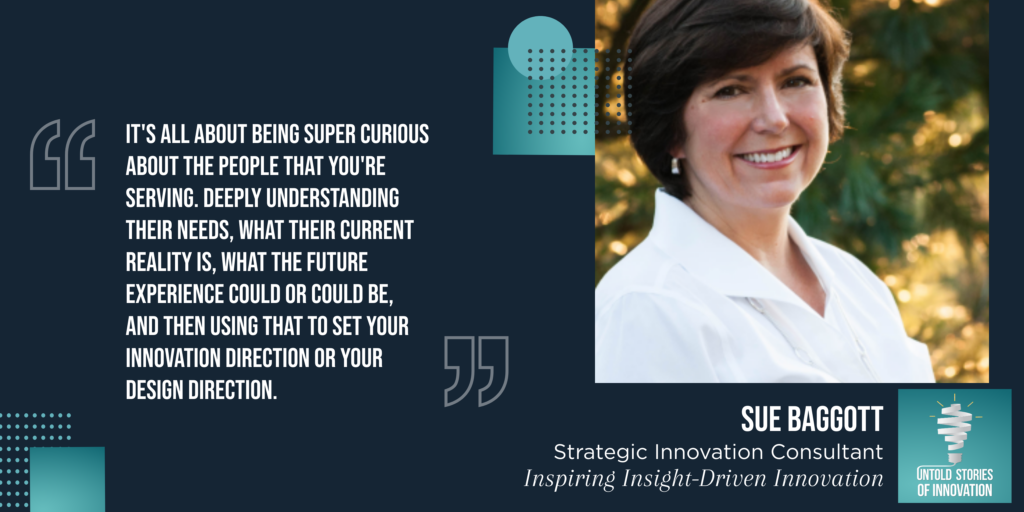
Sue Baggott: [00:14:04] So as we were setting out the aspirations for that design, for that stage of development, we were inspired by that to say, “aren’t there better ways to enable the more ideal experience by crafting a different application that could be done, laying down, standing up, whatever it might be. How can we make that experience more ideal? But the key thing was we would use that alligator video to explain why we were, you know, exploring some very, very different and unique designs for that stage.
Katie Trauth Taylor: [00:14:35] I love that. That’s incredible. You have translated all those insights you gathered around why empathy matters to technical briefs and to creating innovations that matter. Tell us sort of how you translate those insights in your current work as a consultant.
Sue Baggott: [00:14:53] So let me talk about both pieces. From a consultancy standpoint, I think the value that I add is building that innovation capability around empathy. So teaching other organizations or individuals about how to use that human centric empathy approach to first really, truly understand the human experience of the person they’re trying to serve and then figuring out how to add value in that experience. And when you think about solid business innovation, you’ve got the desirability piece. You’ve got the feasibility piece and then you’ve got the viability piece, and those are the key pillars to, you know, successful innovation. So I really focus people on the desirability piece, because, quite honestly, if you’re not making a significant life improvement, the probability that you’re going to get a sustainable business or a meaningful business build is very low. Way too many folks, I find, start with the technology, like, hey, there’s a cool technology. If that technology is not enabling a transformational difference in the human being that it’s designed to serve, then really that’s not meaningful. So I really try to focus first on developing that empathy with your target, documenting that deep understanding of the target, getting very clear on what that target wants out of their lives first. And then how what you design, whether it’s a product or a service or whatever it is. How does your innovation enable them to achieve what they want out of life, how to make an impact on their lives? So that’s the focus of the work now, tools and techniques that I use. I use storytelling extensively. I used it historically and I used to I teach my clients how to use storytelling to get that depth of understanding. Storytelling, particularly if you get consumers telling stories about their thoughts and feelings about their life experience. And you encourage them to use visuals to use words. Right.
Katie Trauth Taylor: [00:16:55] I love, for example. I’m sorry. I don’t mean to interrupt. I love the alligator wrestling example. It’s so visual. Anyone who’s been around a toddler can attest to that experience. And just using that visual metaphor can then if you communicate it well to an innovation team, it can set them off on the ground running to think about different technical solutions to what is really an emotional and functional problem.
Sue Baggott: [00:17:21] Exactly.
Katie Trauth Taylor: [00:17:21] I love that. Yeah, so visual metaphors, you were saying, different strategies.
Sue Baggott: [00:17:25] Yeah. Visual metaphors. So I teach them storytelling because that’s a great way to get the kind of insights you need to develop empathy around the combination of functional and emotional needs that might be present for the consumer. And you’re right. So if you have a really talented technical team and you can give them the problem definition at this higher level, it creates all this space for them to innovate around it. Right. So they know that they’re changing the experience rather than when clients define the innovation space too narrowly. They miss the opportunity to unleash the creativity of amazing technologists, right?
Katie Trauth Taylor: [00:18:05] Yeah, absolutely. It eliminates play. Yeah. From it.
Sue Baggott: [00:18:08] So I would strongly encourage them to first define the desired life experience that they’re trying to enable and then bring it down to the category and then down to the technology. But doing it in that order is really, really important. So you need to do two things. One, when you’re talking to consumers, you need to talk them as humans about their life and their goals and their values and aspirations. You have to start your learning at the life level and then drill down. And then when you’re designing, you need to translate all of that information into the innovation design direction, and then you need to build from the ground up. You can’t you still have to have the functional benefits that, you know, a significant step change in the functional benefits. But if you don’t combine it with the emotional and life level benefits and put all of the cues into that, then you’re not going to get the… Not going to get the transformational change. So use storytelling a lot. Use ethnography a lot. With ethnography, it’s using all of your observational skills to see everything that the consumer has surrounding them in their lives. That’s enabling the experience they want and noticing the gaps even when they don’t. A lot of times consumers, they can explain what the ideal is, but they can’t tell you – they’re not gonna find the solution for you.
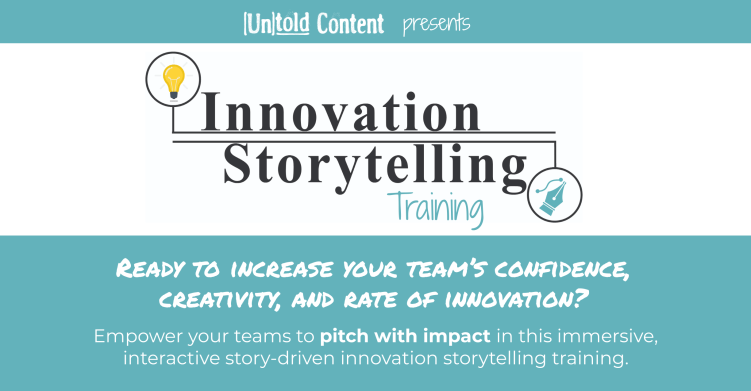
Katie Trauth Taylor: [00:19:27] Sure. Sure. They might not even know exactly how to articulate the problem. But.
Sue Baggott: [00:19:32] That’s the issue, they can’t articulate the problem now.
Katie Trauth Taylor: [00:19:35] Sometimes, yeah.
Sue Baggott: [00:19:35] You can take a look and see. A lot of times they’re compensating behaviors going on or things that you can see that are a disconnect between what their ideal and what they’re doing right now. And because they don’t have any other you know, they don’t have any other solution. So they’re not good at necessarily identifying the exact problem. But if you use good observational skills, good ethnographic research, you can create a consumer model that helps identify those things, create new directions and then prototype and test back with them. If we gave you this, you know, how would that impact you if we gave you that? How would that impact you? And you can you can use like the lean innovation principles of, okay, what are the hypotheses you have about how you might make their lives better and what little pieces of it can you share with them to understand if you’re in the right direction or not?
Katie Trauth Taylor: [00:20:24] I love that so much, there’s so many strategies you just touched on asking “if then how?” Questions to consumers and also the first thing I think is what you really are… One of the key pieces of advice that I’m hearing to the innovation community is that once you have an insight, once you’ve innovated against that insight, when you go back to try to gain buy-in for that solution or that prototype or that approach, remember to tell the whole story. Don’t just tell the technical details, go back to the experience, go back to the emotional social life change kinds of, you know, the rhetoric around that and allow that to be part of the conversation alongside the functional benefits. And that will make it so much easier for senior leadership and other stakeholders to get behind it and see it as aligned with their organizational mission.
Sue Baggott: [00:21:18] Yeah, and that in you, what you said was very, very important around. You need to give consumers the context of what you’re trying to create for them, for them to evaluate. Especially early prototypes, because you’re never gonna get the finished thing. But you need to give them the context of we heard that you would like your life to be more like this. You know, as they look at the prototype, is it enabling even a part of the experience that you wanted to create? And a lot of times when we did early prototype typing or when I’m teaching people about early prototype, a prototype can be anything from a set of words on paper, it could be a sketch or a drawing. It can be, you know, any number of different things that you can. And in fact, storyboards are a great way to prototype experiences. You create a story in words and pictures about what a future life experience could be like. And you look for how the consumers react to this.
Katie Trauth Taylor: [00:22:14] Yes. Yes.
Sue Baggott: [00:22:15] And that saves so much time and money.
Katie Trauth Taylor: [00:22:17] Right. Versus…
Sue Baggott: [00:22:18] You don’t have to actually create it, right?
Katie Trauth Taylor: [00:22:19] Yeah.
Sue Baggott: [00:22:19] You have to allow them to feel the experience of it and understand when you’re getting close to what they really want. So oftentimes I’m teaching customers or clients how to do the empathy building, how to translate that empathy building back into technology direction. And then how did you prototyping in the very broadest sense of the word to test those hypotheses. So it’s very consistent with lean innovation principles.
Katie Trauth Taylor: [00:22:49] Yes.
Sue Baggott: [00:22:49] I just learned it and was doing it before that language came to play. What’s very helpful now is the language of lean innovation helps me in explaining a little more about this iterative approach.
Katie Trauth Taylor: [00:23:04] Absolutely. Yes. Yes. And I love that point that you just made, that the prototyping process itself can rely on story. The story can actually be the prototype. And certainly, no matter whether you have a physical prototype or an actual product, there will always be context to share and there will always be stories surrounding it. And that having that really honed and giving as much consideration and thought to that story as you are to the design is – it’s incredibly important. And it’ll make your innovations far more successful and get more buy-in.
Sue Baggott: [00:23:38] Yeah. So when it comes to startups, one of the things I look for first is how deeply do they understand their customer? Do they have the empathy necessary to create a transformational difference for their customer? So that’s first and foremost. If I don’t see that in a startup, I’m like, okay, you need to go back and do some work.
Katie Trauth Taylor: [00:23:58] Sure.
Sue Baggott: [00:23:58] You need to, because I believe that that deep empathy is what it takes to succeed. To really, truly create something life changing. And I also believe that the you have to have the empathy from the founder of the startup. The founders have got to deeply believe in the life changing difference they want to make. Starting a business is hard.
Katie Trauth Taylor: [00:24:17] Yes. Yeah. Yeah.
Sue Baggott: [00:24:18] People hear the glory stories. It’s hard. It takes time. It takes persistence.
Katie Trauth Taylor: [00:24:23] Yes.
Sue Baggott: [00:24:23] And you’ve got to have a really clear vision of the value you’re trying to create for the people you serve. You’ve got to have that clear. And that’s around that. That’s the empathy. That’s the empathy piece. Then you need to be able to be a great storyteller. You need to get others to buy into your vision so that they can innovate with you or invest alongside you or help you with your networking. You’ve got to do an amazing job of that. And I think that’s why I’ve enjoyed so much working in the kind of what you would call an accidental angel investor. It’s not what I intended to do.
Katie Trauth Taylor: [00:24:56] Sure.
Sue Baggott: [00:24:56] But through a variety of experiences and being exposed to it, I was actually first exposed to it. Queen City Angels was a strategy client of mine, and that’s how I got the insights to learn about angel investing. So I did empathy related interviews for all of their stakeholders, including the investors, the entrepreneurs, the ecosystem partners and their sponsors, and then use those insights to help them with their strategy redirect. And once I got to understand that angel investing is as much about community development as it is about the investment and returns. Don’t get me wrong. They want returns, but a lot of them. There’s a lot easier ways to just make money. Angel investors are typically out there doing this work because they enjoy helping entrepreneurs.
Katie Trauth Taylor: [00:25:36] Yes. So much of it seems to be about mentorship.
Sue Baggott: [00:25:39] There’s a ton about, you know, about mentorship, about connection.
Katie Trauth Taylor: [00:25:41] Impact. Yeah.
Sue Baggott: [00:25:43] And impact. And so that’s the other thing that I look for in startups. One, do they have the empathy and the vision and then. Is there that mission that they’re driving towards something that I think is going to make a positive impact in the world? And so that’s the kind of combination of in terms of the investing that I do now. Yes, I do some general angel investing, but I also look particularly to do angel investing where it’s going to make that positive – I get particularly excited about startups that have that positive mission at their core and a way to scale it and a way to grow and scale it. Those are the entrepreneurs I like to invest in.
Katie Trauth Taylor: [00:26:23] Yes. I love that you shared your experience as a strategist and how you sort of coach companies and startups. You shared your experience as well from an investor’s point of view and why story might be important to building that relationship with investors and getting them to believe, not just your consumer. And it’s a slightly different kind of story to tell, but it’s – all of it is important to the growth and the health of your big idea.
Sue Baggott: [00:26:51] Yeah.
Katie Trauth Taylor: [00:26:51] I’m so grateful to have you on the podcast to talk through all of these different strategies and to hear so many stories about how you’ve used empathy to fuel innovation. Thank you so much for being here.
Sue Baggott: [00:27:02] Thank you so much for having me.
Katie Trauth Taylor: [00:27:07] Thanks for listening to this week’s episode. Be sure to follow us on social media and add your voice to the conversation. You can find us @untoldcontent.
*Interviews are not endorsements of individuals or businesses.

